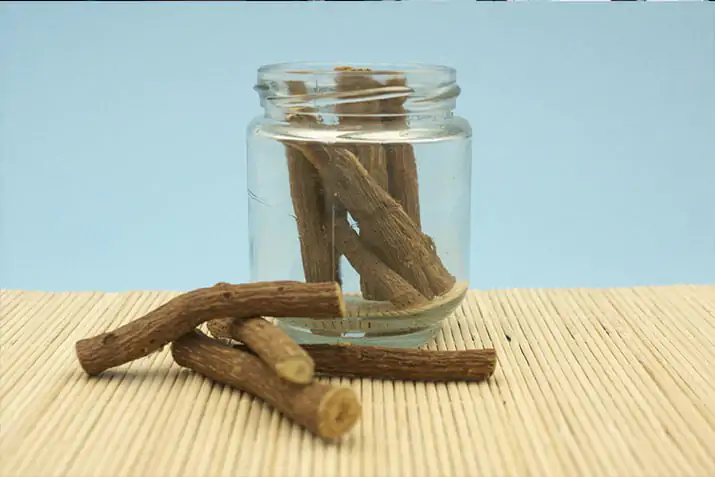Licorice root isn’t just a candy flavor – it’s a skincare powerhouse with a long history. Used in ancient traditions for soothing skin concerns, licorice root extract is now a trusted ingredient in modern routines. In this guide, you’ll see why licorice helps skin, how to use it, and what science-backed benefits to expect.
What Is Licorice Root & Why It’s Used in Skincare
Origin & history. Licorice comes from the Glycyrrhiza plant family and has been used for centuries in topical remedies to soothe irritated skin and support recovery.
Key compounds.
- Glabridin: Antioxidant that inhibits tyrosinase, the enzyme involved in melanin production.
- Liquiritin: Helps disperse existing melanin, softening the look of dark spots.
- Licochalcone A: Strong anti-inflammatory that also helps balance oil.
- Glycyrrhizin: Soothing, humectant-like action that supports barrier hydration.
Why people love it.
Top Benefits of Licorice Root for Skin
1. Brightens & Evens Skin Tone
Glabridin helps limit excess melanin, while liquiritin supports the removal of already-formed pigment. With steady use, many see a more even, radiant tone. In clinical contexts, licorice derivatives have shown results comparable to common brighteners, with fewer irritation concerns.
2. Calms Inflammation & Redness
Licochalcone A and glycyrrhizin help reduce visible redness and itching. Research has reported improvements in eczema-like symptoms with topical licorice preparations, offering comfort without relying on steroid creams for day-to-day use.
3. Antioxidant Support (Anti-Aging & UV Stress)
Licorice contains flavonoids that neutralize free radicals from UV and pollution. Studies indicate glabridin can help buffer UV-related oxidative stress. It’s not sunscreen, but it supports your skin’s defenses and helps limit the look of photoaging.
4. Acne Support
Licorice shows antimicrobial activity relevant to acne-related bacteria and helps calm inflammatory lesions so breakouts look less red and angry. Early findings suggest licochalcone A may also help moderate oil activity.
5. Oil Control & Balance
By soothing inflammatory pathways in oil glands, licorice can help reduce midday shine and support a more balanced complexion without harsh stripping.
6. Hydration & Barrier Care
Glycyrrhizin behaves like a humectant, attracting moisture and supporting barrier comfort. This can soften the feel of dryness and reduce the look of fine, dehydration lines.
7. Healing & Scars
Antioxidant and anti-inflammatory effects contribute to faster visible recovery after irritation. Clinical work has reported improved healing timelines in wound settings with licorice-based topicals, suggesting value for post-blemish marks as part of a broader routine.
8. Generally Gentle
Licorice extract is well-tolerated by most skin types, including sensitive and mature skin, making it a smart option when stronger actives are off the table.
How to Use Licorice Root in Your Routine
Pick the right format.
- Serum: Best for dark spots and uneven tone.
- Moisturizer/Lotion: Ongoing redness, sensitivity, and hydration.
- Cleanser/Toner: Gentle, gradual support.
Be consistent. Most people do well with daily use (once or twice a day), following the product’s directions. Visible results typically build over several weeks.
Smart pairing. Licorice works well with vitamin C, niacinamide, tranexamic acid, kojic acid, hyaluronic acid, and gentle exfoliants. If you use strong retinoids or peels, consider alternating routines to keep irritation low.
Sunscreen is essential. For brightening to last, wear broad-spectrum SPF 30+ every morning.
Patch test first. Reactions are uncommon, but sensitive users should apply a small amount behind the ear or inner arm and wait 24 hours before full-face use.
DIY options. A simple mask with licorice powder mixed into aloe, yogurt, or honey can be soothing. Effects are milder than a well-formulated serum; always patch test.
Oral use caution. This guide focuses on topical benefits. Oral licorice (tea/supplements) can affect blood pressure and hormones; consult a clinician before ingesting regularly.
Side Effects & Precautions
- Generally well-tolerated. Allergic responses are rare.
- Possible mild irritation. Start slowly if your skin is reactive.
- Don’t overuse. Extremely high or excessive frequency could, in theory, lead to unwanted lightening; follow label directions.
- Pregnancy & health. Topical use is typically acceptable; oral forms are not advised in pregnancy. If you have blood pressure or endocrine concerns, talk to your provider.
Frequently Asked Questions (FAQs)
Does it really lighten dark spots?
Yes. Compounds such as glabridin (limits new pigment) and liquiritin (helps disperse existing pigment) support gradual fading with consistent use, as shown in multiple studies.
How long until I see results?
Subtle changes may show in 2-4 weeks, with clearer improvements around 4–8 weeks, assuming daily use and diligent sun protection.
Is it safe for sensitive or eczema-prone skin?
Generally, yes. Licorice has soothing properties and has reduced eczema-like symptoms in clinical settings, though you should still patch test.
Can I use it every day?
Most users can apply licorice once or twice daily. If using stronger actives, alternate routines to keep irritation in check.
Do I still need sunscreen?
Absolutely. Licorice supports defense against oxidative stress, but it doesn’t replace SPF.
What form is best?
For noticeable results, choose standardized extracts (serums/creams) from reputable brands. DIY masks are nice add-ons but weaker.
Conclusion
Licorice root brings brightening, soothing, antioxidant, and barrier-friendly benefits together in a single, gentle ingredient. With steady use, and daily SPF, you can expect a calmer complexion, fewer visible dark spots, and healthier-looking skin over time.


